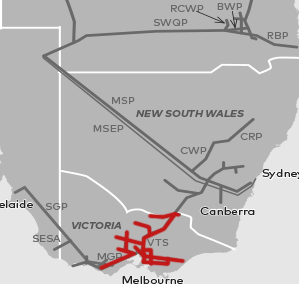The Victorian Transmission System (VTS) has also been known as the Declared Transmission System (DTS), the Principal Transmission System (PTS) and the APA GasNet System. Since 2002, it includes the former Western Transmission System (WTS) which transported gas to Portland, Hamilton and Cobden.
The VTS is a transmission pipeline network owned by APA Group through its wholly owned subsidiary APA VTS Australia (Operations) Pty Ltd. APA acquired the VTS when it purchased GasNet Australia in December 2006.
The VTS transports natural gas within Victoria, supplying the Melbourne metropolitan area and country areas. It also supplies gas to NSW via the Interconnect with the Moomba Sydney Pipeline (MSP) at Culcairn and to South Australia via the SEA Gas Pipeline at Port Campbell. The average annual throughput of the VTS is in excess of 200 PJ per annum.
Construction of the VTS began in the mid-1950s and it currently consists of over 2000km of pipeline. Gas can enter or exit the system from the Longford gas plant and the VicHub in the east, Culcairn in NSW, the western underground gas storage (WUGS) facility at Iona, the SEA Gas Pipeline, Otway Gas Plant and Mortlake Pipeline through their connection to the SEA Gas Pipeline at Port Campbell, the Pakenham facility and the Dandenong LNG facility. Gas can also be injected from the Tasmanian Gas Pipeline (TasHub) into the VTS at Longford. Gas is principally sourced from offshore gas fields in the Gippsland, Bass and Otway basins.
The capacity of the VTS has been progressively expanded between 2014 and 2017 to transport additional gas between NSW and Victoria at Culcairn. In 2015, additional capacity on the South West Pipeline was added for gas flows from the facilities at Iona and the SEA Gas Pipeline at Port Campbell.
The VTS operates under a market carriage system rather than a contract carriage system. It is operated by AEMO (previously VENCorp) who also operates the Declared Wholesale Gas Market in Victoria.
The VTS was a covered pipeline under the Gas Code and was regulated by the ACCC. Under the Gas Code, the initial access arrangements approved by the ACCC were for the PTS, WTS and VENCorp (as the PTS pipeline operator, VENCorp was considered as a service provider). Subsequently, only one access arrangement was required for the PTS and WTS when the pipelines were connected to form the VTS.
In addition, AEMO is no longer required to submit an access arrangement for the VTS although it remains the pipeline operator.
In enacting the National Gas Law and Rules, the National Gas (Victoria) Act 2008 specifies that access arrangements cannot be consolidated for any of the covered pipelines in Victoria (s. 35). This includes the VTS.
In addition, under the National Gas (Victoria) Act 2008, the Victorian Minister has by order published in the Victorian Government Gazette (S222, 30 June 2009) declared that the four distribution pipelines and the transmission pipeline that had been covered under the Gas Code are classified as ‘designated pipelines’. These are the AusNet Services, Australian Gas Networks (Vic), Multinet and Australian Gas Networks (Albury) gas distribution networks and the Victorian Transmission System. As a result, these pipelines remain under full regulation and cannot be the subject of a light regulation determination (under ss. 109 and 111 of the NGL).
The VTS remains a covered pipeline under the NGL, and is regulated under the NGR by the AER.
